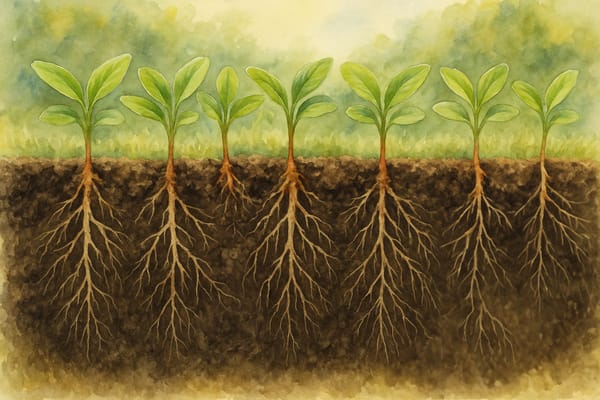Building a garden begins beneath your feet.
Long before seeds are sown or petals bloom, every good garden begins with one quiet question: what kind of soil am I working with? In Cornwall, where cliffs meet clay and moorland meets sea, understanding the ground beneath us isn’t just helpful—it’s essential.
Soil is not just “dirt.” It’s a living, breathing ecosystem made up of minerals, organic matter, moisture, air, and a vibrant underground world of worms, fungi, and microscopic life. And whether you're nurturing a flower border on the coast or a veg patch in a sheltered valley, the health of your soil will determine the success of everything that grows.
The Six Faces of Soil
In Cornwall, garden soil rarely fits into one neat category. But understanding the types will help you make better decisions for planting and care.
- Sandy Soil is light, fast-draining, and warms quickly—ideal for early sowings, though it needs regular feeding and mulching to avoid drying out.
- Clay Soil is rich and heavy, holding onto nutrients but also water. When managed with patience and organic matter, it becomes incredibly fertile.
- Loamy Soil is the gardener’s dream—crumbly, well-drained, and balanced. If you’re lucky enough to have it, treat it well.
- Silty Soil feels soft and silky. It can be wonderfully fertile but needs organic matter to avoid becoming compact and soggy.
- Chalky Soil often drains fast and leans alkaline. It suits many Mediterranean plants but can be a challenge for acid-lovers like camellias or rhododendrons.
- Peaty Soil, dark and rich in organic matter, is moisture-retentive and often acidic—good for woodland plants, but prone to waterlogging if not managed.
Most Cornish gardens are a blend, with subtle shifts in texture, depth, and structure from one border to the next. The secret lies in getting to know your soil personally—handful by handful.
Getting to Know Your Soil
Take a moment, and dig.
Rub a pinch of moist soil between your fingers. Gritty? Likely sandy. Sticky? Clay. Silky-smooth? That’s silt. The ideal—loam—crumbles gently in your palm.
Try the drainage test: dig a small hole and fill it with water. If it drains too fast or sits like a puddle, you’ll need to adjust with compost or raised beds.
And don’t forget the worms. Their presence is a welcome sign that your soil is thriving.
The Role of pH: Acid or Alkaline?
Soil pH affects how plants access nutrients. Cornwall’s soils lean slightly acidic in many places, especially where peaty or sea-influenced soils dominate. Acid-loving plants like blueberries, hydrangeas, and azaleas thrive here, but it’s always worth testing.
You can buy a simple pH testing kit—or dig a little deeper with a meter. If the soil is too acidic, lime can gently balance it. Too alkaline? Add sulphur or lots of rich organic matter.
Nurturing Your Soil
Soil care is not just about solving problems—it's about fostering a living foundation.
- Add organic matter like compost, leaf mold, or well-rotted manure each season to feed soil life and improve structure.
- Mulch with compost, straw, or bark to conserve moisture, suppress weeds, and enrich the soil as it breaks down.
- Avoid heavy digging where possible. No-dig or low-till gardening keeps the delicate underground networks intact—especially important in Cornwall’s often fragile soils.
- Rotate crops and grow green manures to naturally replenish nutrients and break pest cycles.
- Keep soil covered. Bare soil is vulnerable—protect it with plants, mulch, or cover crops through every season.
Troubleshooting Common Problems
- Waterlogged beds? Add organic matter or elevate with raised beds.
- Tired soil and poor yields? Feed it well with compost and rotate plant families.
- Hard and compacted? Loosen gently with a fork, never when sodden, and mulch to attract worms.
- Yellowing acid-lovers? Your soil might be too alkaline—try ericaceous compost or natural pH adjusters.
Your Garden Begins in the Ground
Soil may not be the most glamorous part of the garden, but it is without doubt the most important. Beneath every bloom and harvest lies a universe of life—and your role as a gardener is to protect and nurture it.
Whether you garden on windswept clay or sandy coastal plots, the path to a thriving garden begins with curiosity, care, and a handful of soil. Start there—and you’re already halfway to success.








